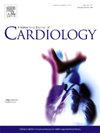Intra-aortic balloon pump implantation in early-stage cardiogenic shock reduces 30-day mortality in patients with ventricular septal defect following myocardial infarction
IF 3.2
2区 医学
Q2 CARDIAC & CARDIOVASCULAR SYSTEMS
引用次数: 0
Abstract
Background
Ventricular septal defect (VSD) is a serious mechanical complication of acute myocardial infarction, with an extremely high mortality. Intra-aortic balloon pump (IABP) has become a bridge to surgical repair. However, its effect on mortality varies partly because of shock severity.
Aims
This study aims to evaluate the association between IABP implantation in early-stage cardiogenic shock and the 30-day all-cause mortality in patients with VSD after myocardial infarction (MI-VSD).
Methods
The retrospective data were collected based on MI-VSD patients who were admitted to Qilu Hospital of Shandong University from 2013 to 2024. Patients were stratified according to IABP implantation. We determined the severity of shock according to the Society for Cardiovascular Angiography and Interventions (SCAI) SHOCK stage classification system. The primary outcome was all-cause mortality within 30 days after VSD. Logistic regression models were constructed to evaluate the factors associated with the 30-day all-cause mortality. We conducted subgroup analysis and assessed interaction effects to evaluate the relationship between IABP use and 30-day mortality in various subgroups. The Kaplan-Meier curves were used to determine the cumulative incidence of 30-day mortality. We also compared the long-term outcomes of the patients.
Results
This study included a total of 57 patients, 33 of whom received IABP implantation. The SCAI SHOCK stage was associated with 30-day all-cause mortality. IABP implantation significantly reduced 30-day mortality in patients with SCAI SHOCK stages A/B (6.7 % versus 55.6 %; OR 0.06, 95 % CI 0.01–0.64, P = 0.020), while no significant difference was observed in stages C/D/E patients. We also found that IABP implantation effectively prevented progression to stages C/D/E in stages A/B patients. In addition, IABP treatment in SCAI SHOCK stages A/B significantly elevated the long-term survival rate.
Conclusions
Implantation of IABP in SCAI SHOCK stages A/B could reduce 30-day all-cause mortality in MI-VSD patients.
主动脉内球囊泵植入术治疗早期心源性休克可降低心肌梗死后室间隔缺损患者30天死亡率
背景:室间隔缺损(ventricular septal缺损,VSD)是急性心肌梗死的严重机械并发症,死亡率极高。主动脉内球囊泵(IABP)已成为外科手术修复的桥梁。然而,它对死亡率的影响在一定程度上取决于休克的严重程度。目的本研究旨在评估早期心源性休克患者植入IABP与心肌梗死(MI-VSD)后VSD患者30天全因死亡率的关系。方法回顾性分析2013 - 2024年山东大学齐鲁医院收治的MI-VSD患者的临床资料。根据IABP植入情况对患者进行分层。我们根据心血管血管造影和干预协会(SCAI)休克分期分类系统确定休克的严重程度。主要终点为室间隔缺损后30天内的全因死亡率。建立Logistic回归模型评价与30天全因死亡率相关的因素。我们进行了亚组分析,并评估了相互作用效应,以评估不同亚组中IABP使用与30天死亡率之间的关系。Kaplan-Meier曲线用于确定30天死亡率的累积发生率。我们还比较了患者的长期预后。结果本研究共纳入57例患者,其中33例接受IABP植入。SCAI休克期与30天全因死亡率相关。IABP植入显著降低SCAI SHOCK A/B期患者的30天死亡率(6.7%对55.6%;OR 0.06, 95% CI 0.01-0.64, P = 0.020),而在C/D/E期患者中无显著差异。我们还发现IABP植入有效地阻止了A/B期患者进展到C/D/E期。此外,IABP治疗SCAI SHOCK A/B期显著提高了长期生存率。结论在SCAI休克A/B期植入IABP可降低MI-VSD患者30天全因死亡率。
本文章由计算机程序翻译,如有差异,请以英文原文为准。
求助全文
约1分钟内获得全文
求助全文
来源期刊

International journal of cardiology
医学-心血管系统
CiteScore
6.80
自引率
5.70%
发文量
758
审稿时长
44 days
期刊介绍:
The International Journal of Cardiology is devoted to cardiology in the broadest sense. Both basic research and clinical papers can be submitted. The journal serves the interest of both practicing clinicians and researchers.
In addition to original papers, we are launching a range of new manuscript types, including Consensus and Position Papers, Systematic Reviews, Meta-analyses, and Short communications. Case reports are no longer acceptable. Controversial techniques, issues on health policy and social medicine are discussed and serve as useful tools for encouraging debate.
 求助内容:
求助内容: 应助结果提醒方式:
应助结果提醒方式:


